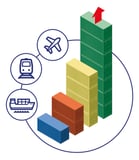Supply Chain Conversations: An Interview with flexis’ Robert Recknagel
Nick Ostdick - August 24, 2017

Today’s blog entry features a fascinating conversation with flexis AG Vice President of Manufacturing and Logistics Robert Recknagel. As a thought-leader in the supply chain landscape with more than 10 years of experience in operational supply chain management, software concepts and optimization design, Recknagel provided us a glimpse into the key conversations, discussions, and concerns manufacturing companies are addressing in today’s global manufacturing landscape. Recknagel’s work with flexis has largely focussed on helping companies administer their supply networks as efficiently and productivity as possible, which uniquely positions him to shed light on the challenges and opportunities today’s manufacturers see each and every day.
Nick Ostdick: There’s a lot of information in today’s supply chain about Industry 4.0. Can you clarify a little bit about what Industry 4.0 means for the manufacturing supply chain and how companies should be looking to implement this technology platform?
 Robert Recknagel: Industry 4.0 is really built on the idea of increasing end-to-end visibility, agility, and flexibility across every touch point of the value chain, in both a horizontal and vertical manner. It’s a move via a variety of technology and software toward a holistic, digital reimagination of manufacturing and supply processes. Because of the variant-rich nature of today’s manufacturing industry, Industry 4.0 helps companies answer the question: How do I reduce overall operational costs while still being nimble enough to respond to unforeseen changes in planning or production programs?
Robert Recknagel: Industry 4.0 is really built on the idea of increasing end-to-end visibility, agility, and flexibility across every touch point of the value chain, in both a horizontal and vertical manner. It’s a move via a variety of technology and software toward a holistic, digital reimagination of manufacturing and supply processes. Because of the variant-rich nature of today’s manufacturing industry, Industry 4.0 helps companies answer the question: How do I reduce overall operational costs while still being nimble enough to respond to unforeseen changes in planning or production programs?
A successful implementation or adoption of Industry 4.0 depends on a number of critical variables all designed in conjunction with lean manufacturing and supply principles designed to eliminate waste and underused resources across the supply chain. Some of the variables include elements like the transparency of vital information and data; the interoperability of people, systems, and machines to communicate and coordinate production; and decentralized, automated decision-making processes. These aspects of Industry 4.0 not only help manufacturers become more agile and responsive, but they also help drive down costs and increase ROI.
Let’s talk for a moment about lean manufacturing principles, especially as manufacturing companies and others in the supply chain look to foster increased end-to-end visibility (E2E) and transparency in their operations. What are some steps companies can take to become more agile and responsive to the pressures of a variant-rich industry?
Well, as we just discussed, understanding the value and importance of adopting Industry 4.0 certainly goes a long way toward achieving this goal. But manufacturing companies must also look toward how they gather, analyze, and distribute data as a key driver of agility and responsiveness. Today’s global manufacturing and supply network is really based on data and reporting. Understanding how your supply stream operates (the positives, the negatives, etc) is critical in determining how to best integrated new solutions and strategies to increase your efficiency and transparency. This is where concepts like advanced analytics and Big Data play a large role in helping manufacturers understand the functionality of their value streams.
I would also argue complete integration of the planning and execution processes are an important part of creating agility and responsiveness. The idea that planning and production are two disparate parts of the entire manufacturing scheme is outdated thinking. Companies must work to integrate these tasks if they want to break down cross-functional silos, increase communication and coordination between planning and production, and ultimately make more informed decisions about how to create and move products with the greatest amount of efficiency. I call this development from organizational siloes to centers of excellence. Today's corporate environments get more and more complex. The power of industry 4.0 initiatives lies in intelligent linkages between specialized corporate functions. Bringing together teams in collaborative ways to allow them generating joint value by synchronizing their work. Synchronizing sales plans with operational capabilities; synchronizing sales plans to purchasing departments; synchronizing production planning with executional shopfloor feedback- these are just some examples of how to use industry 4.0 concepts to generate additional value.
Digitization and connectivity have become critical for companies in the supply stream. What are some of the common roadblocks or challenges companies face in achieving a connected, digitized supply chain?
If we understand supply chain digitization as the movement toward a completely integrated sequence of planning and production solutions that work in tandem to create a more visible and agile supply stream across, then it’s pretty clear why this topic is top priority for companies looking to remain competitive and growth-oriented. Digitization not only helps companies function more efficiently and effectively, but it also provides companies the responsiveness and agility necessary to address and avoid potential breakdowns in demand planning, production, transportation, and yard or container management.
First would be the integration of existing systems with new or reimagined supply chain solutions. Because the nuances of today’s automotive supply chain are vast and varied, companies often have a number of different planning, production, and reporting/data management solutions deployed simultaneously. Creating a digital supply chain strategy requires a top-to-bottom, soup-to-nuts approach that brings each application under the same umbrella. Successful creation and implementation of such a strategy will help eliminate functional silos and increase communication and collaboration surrounding planning and production benchmarks and goals.
Secondly, I would say connecting disparate data points and sources. Via the IOT, digitizing the supply chain connects various methods of collecting, sorting, and evaluating data to help planners and managers create more accurate forecasts of demand for more effective planning strategies. The connection of data sources helps planners and managers create enhanced what-if scenarios and simulations, both of which are critical for driving planning schemes for production programs. Failure to administer and manage these connections means critical data points and actionable data will not be utilized in understanding how effective and responsive a company’s planning and production strategies can be.
Last, though certainly not least, maintaining communication and collaboration. Digitizing the supply chain is a critical move toward eliminating communication silos across an organization. This means major players within the supply stream will have a greater capacity to share data, collaborate on important initiatives, and work in conjunction to ensure smooth workflows free of bottlenecks, disruptions, or breakdowns. Because a digitized supply chain is based in part on a central hub of data storage with multiple access points, gone are the days when those within the supply stream had to wait days or weeks to review data sets and communicate the results of said data. Those within the supply stream need to access data and communicate its importance in real-time, which is a core driver of end-to-end (E2E) visibility.
Finally, as we move further into 2017, what might be the key conversations and discussions for companies surrounding Industry 4.0 and its associated concepts? What will thought leaders in the industry be most concerned with as we move through the rest of the year?
I think 2017 will prove to be an important and busy year in global manufacturing and supply. You know, last year we heard and saw so much movement toward topics we’ve already discussed in this interview - Industry 4.0, Big Data, advanced analytics, and so on. I don’t think those concerns are going to diminish as we move through 2017 in large part because a healthy amount of the global manufacturing industry is still coming online with these ideas and concepts. But what I think will dominate the conversation in 2017 are the subplots of these big picture discussion. For example, I think the continued demand for increased visibility will certainly be a major talking point this year, especially with the push for more lean manufacturing and supply principles. Industry insiders should also expect the desire for enhanced visibility to move beyond the production floor to warehouse management, yard, dock, and container management, and transportation management as well.
In addition, I think another focal point of discussion this year will center on how companies can make their supply streams more responsive to the volatile nature of their production networks. Because companies today work with so many and varied suppliers, production partners, distributors, retailers, etc, there is such complexity and nuance involved in administering a successful value chain from top to bottom. As a result, I think manufacturing companies are constantly addressing how to best deal with the potential for disruptions and bottlenecks in all aspects of their supply stream. While once again technological advances in intelligent planning solutions will help drive this movement, expect conversations about fully-integrated operations across each touch point of a company’s value chain to become quite common as companies look to completely digitize and integrate every stage of the production and supply process.
We’d like to thank Robert for his time, thoughts, and insights on today’s global manufacturing and supply network, and for providing us with an insider’s perspective as to how companies think, feel, and address the most pressing concerns in modern manufacturing.
If you want to learn more get your Guide to Industry 4.0:
LATEST POSTS
- Understand Circular Economy in The Manufacturing Industry
- How Can Industry 4.0 IT Integration Be Achieved Smoothly?
- The Significance of Order Sequencing in Discrete Manufacturing
- How to improve your Supply Chain Management: The Power of Control Towers
- Optimizing Human Resource Scheduling in Manufacturing: A Technological Approach



